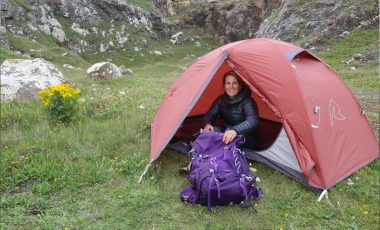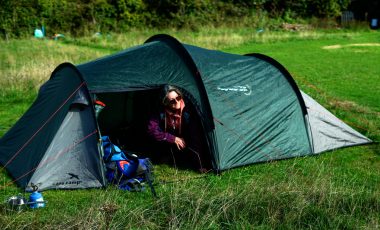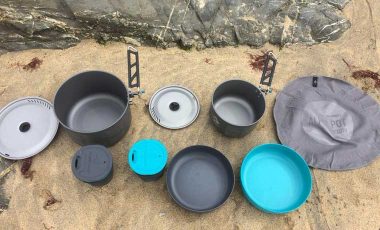An exceptionally spacious, highly liveable family tent, with a very appealing price tag
Tunnel tents are renowned for their spaciousness and offer families and groups comfort and luxury when out camping. But they are also notoriously inept at dealing with windy conditions. So Vango, in their wisdom, have created a range of tunnel tents that incredibly stable without compromising on liveability. The Vango Drummond 500 is one such tent that expertly holds up to all but the worst conditions and houses up to 5 people in comfort and luxury. Read on to see how they managed it and why we love the Drummond 500 so much.
Vango Drummond 500: the stats
| Weight: | 13.2 kg / 29.1lbs |
| Inner tent dimensions: | 210 x 300 x 200 cm / 8.9 x 9.8 x 6.5 ft (L x W x H) |
| Outer tent dimensions: | 495 x 320 x 210 cm / 16.2 x 10.4 x 6.8 ft (L x W x H) |
| Fy fabric: | Protex 70D (100% polyester) 4000 mm water column |
| Floor fabric: | 100% polyester; 10,000 mm water column |
| Poles: | Powerflex fiberglass |
| Entrances: | 2 |
| Sleeps: | 5 |
Features of the Vango Drummond 500
Porch
 The porch is huge! It’s bigger than the sleeping area with steep sides and a sloping front making it very comfortable to hang out in. There’s plenty of space to cook in and at 2.1m high there’s no hunching needed for even the tallest of inhabitants. There are two large entrances on each side of the porch. One has a zippered mesh screen to keep the beasties out, with a waterproof door over the top.
The porch is huge! It’s bigger than the sleeping area with steep sides and a sloping front making it very comfortable to hang out in. There’s plenty of space to cook in and at 2.1m high there’s no hunching needed for even the tallest of inhabitants. There are two large entrances on each side of the porch. One has a zippered mesh screen to keep the beasties out, with a waterproof door over the top.Porch groundsheet
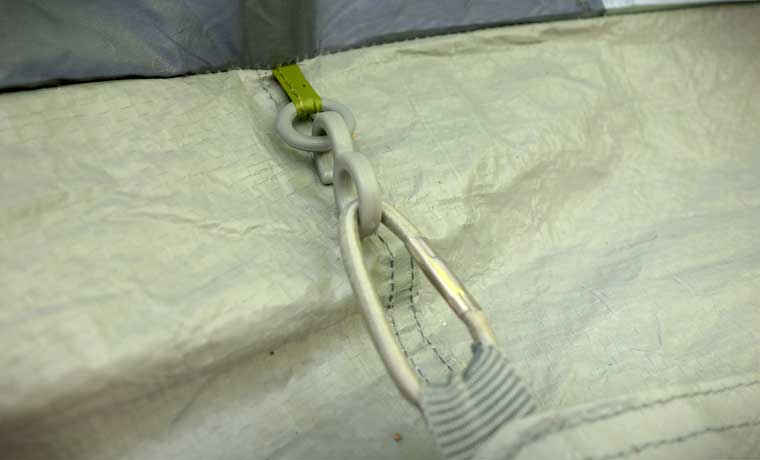 I love the design of the porch groundsheet. It’s part of the inner tent, and is then fastened onto the outer tent with simple toggles. This design means that you can easily sweep the porch floor (just untoggle and brush the mess onto the ground below!).
I love the design of the porch groundsheet. It’s part of the inner tent, and is then fastened onto the outer tent with simple toggles. This design means that you can easily sweep the porch floor (just untoggle and brush the mess onto the ground below!).
Door tiebacks
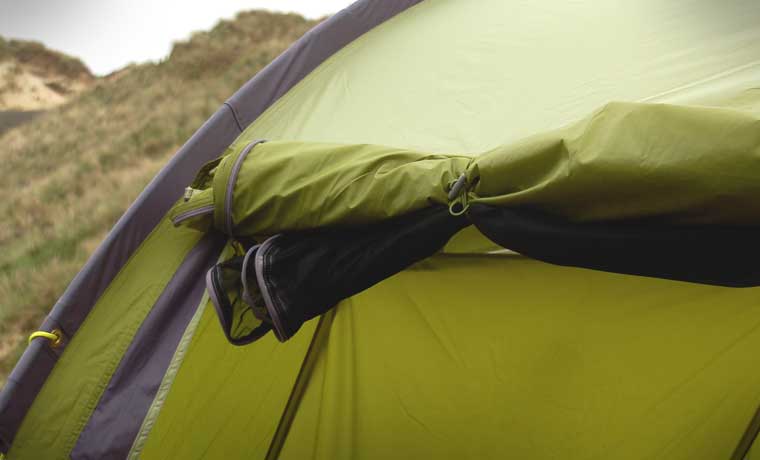 Both doors roll up to the top and are fastened with simple toggles. The same toggle system is used to secure the doors of the inner tent to the central column.
Both doors roll up to the top and are fastened with simple toggles. The same toggle system is used to secure the doors of the inner tent to the central column.
Windows
 The front of the porch features a large bay area with two triangular side windows and one large front window. These have ‘curtains’ attached to them that roll to the side or bottom of the windows and are toggled in place.
The front of the porch features a large bay area with two triangular side windows and one large front window. These have ‘curtains’ attached to them that roll to the side or bottom of the windows and are toggled in place.
Gear loops
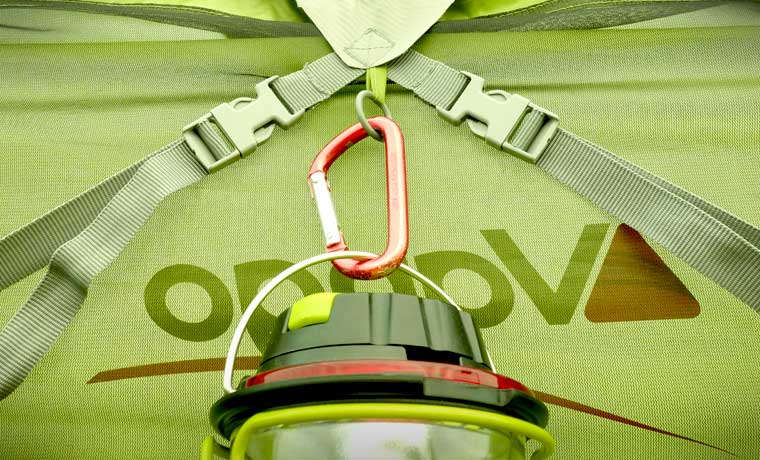 There are a couple of loops in the ceiling of the tents that are strong and well placed to hang lanterns from. The two in the porch are at the highest point in the ceiling and make good washing line anchors to dry stuff overnight.
There are a couple of loops in the ceiling of the tents that are strong and well placed to hang lanterns from. The two in the porch are at the highest point in the ceiling and make good washing line anchors to dry stuff overnight.
Vents
 At the front and rear of the outer tent there are mesh covered vents to allow airflow. The rear vent has guylines attached to the flap which keep it permanently open, whilst the front vent has small tabs that prop the vent open if desired.
At the front and rear of the outer tent there are mesh covered vents to allow airflow. The rear vent has guylines attached to the flap which keep it permanently open, whilst the front vent has small tabs that prop the vent open if desired.
Tension system
 Integrated into the outer fly are two Tension Band Systems (TBS). These are detachable at one end with a buckle and can be stowed in their own pocket when not in use. Their purpose, when connected and tightened, is to increase the stability of the tent in windy conditions.
Integrated into the outer fly are two Tension Band Systems (TBS). These are detachable at one end with a buckle and can be stowed in their own pocket when not in use. Their purpose, when connected and tightened, is to increase the stability of the tent in windy conditions.
Internal pockets
 The inside of the inner features highly useful pockets for organising your gear. There are five pockets on each side which fit loads of bits and bobs like head torches, books, glasses, water bottles etc.
The inside of the inner features highly useful pockets for organising your gear. There are five pockets on each side which fit loads of bits and bobs like head torches, books, glasses, water bottles etc.
Inner tent connectors
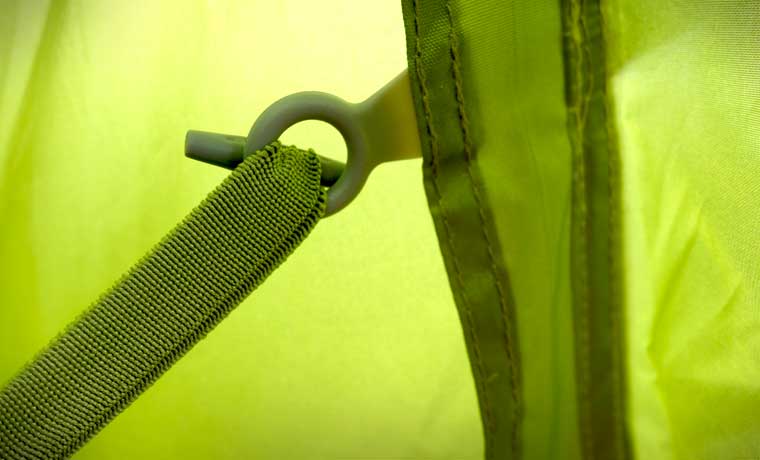 Once the outer fly is set up, the inner tent connects to the inside of the fly using toggles. These pop into place really easily with larger clips securing the bottom corners of the inner.
Once the outer fly is set up, the inner tent connects to the inside of the fly using toggles. These pop into place really easily with larger clips securing the bottom corners of the inner.
Divider
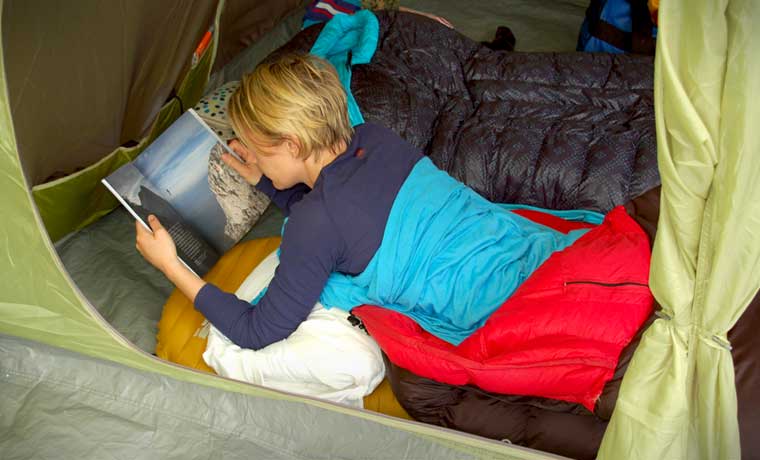 There are more toggles inside the inner section of the tent that allow you to hang up a divider. This can be done in two places. Either directly down the middle to create two evenly sized sections — ideal for four sleepers. Or offset to one side to for two sleepers to be separated from the other three.
There are more toggles inside the inner section of the tent that allow you to hang up a divider. This can be done in two places. Either directly down the middle to create two evenly sized sections — ideal for four sleepers. Or offset to one side to for two sleepers to be separated from the other three.
Stakeouts
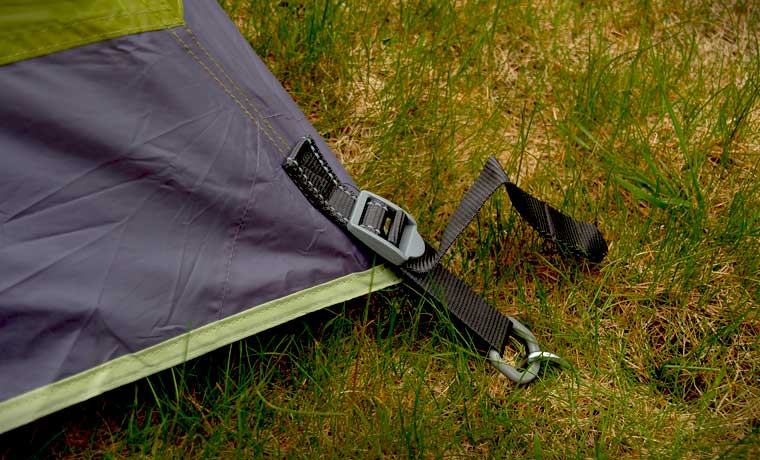 The main stakeouts have adjustable straps that allow you to really cinch the tent down tightly once the pegs are in place.
The main stakeouts have adjustable straps that allow you to really cinch the tent down tightly once the pegs are in place.
Guylines
 Bright yellow guylines help to maximise the stability of the tent in windy weather. They all have adjustment points to create as much tension as needed.
Bright yellow guylines help to maximise the stability of the tent in windy weather. They all have adjustment points to create as much tension as needed.
Vango Drummond 500 review
Set up
The first time I pitched the this tunnel style tent was in my back garden with very limited space. I did it on my own and it took around 15 minutes. It was super straightforward, and totally manageable without needing to be tall to do it (I’m 5’5”). In windy conditions it helps to have a second pair of hands, but it’s still doable on your own. But the more hands the better — it flies up on minutes with a few of you.
The folding poles feed through external tubes on the rainfly. Stake everything down and you’ve got yourself a huge space where you can regroup out of the rain and wind before setting up the inner tent in the dry. This simply clips onto the ceiling rings and floor hooks of the outer.
Liveability
For two people the Drummond 500 is a veritable palace that I could happily live in for months at a time. Add in another two or three people and things become a little more cosy in the sleeping area but still highly comfortable. Plus, the massive porch can easily handle or the extra personal gear that overflows from the inner tent.
The steep side walls create loads of headroom, especially in the porch, and really maximises the large floorplan. But it’s not just the space makes this tent so liveable. The light is also key. The three windows in the porch allow a ton of light to flood in during daylight hours. This is really lovely if you need to be inside to shelter from the rain, wind or from mosquitos and midges. You don’t feel like you’re missing out on outdoor time, and still get to enjoy the view.
Stability
Tunnel tents are notorious for being unstable in windy conditions. But they’re great for maximising liveable space. This is somewhat problematic when, in the ideal world, it would be nice to have both. So Vango developed TBS (Tension Band System). As mentioned, this is designed to stabilise tunnel tents when the wind picks up. We’ve had a couple of very windy nights in the Drummond, and I’ve been super impressed with how it’s held up. Very little swaying, and certainly no bending of collapsing of the poles. The worst we encountered was being kept awake by the noise of the flapping outer. This was easily remedied by tightening up the front guyline. Otherwise, Vango are on to something good with this new system.
Durability
The poles feel supremely strong! It amazes me how they have any bend in them. They are heavy due to this, but in a tent this size, there’s no need to worry about those extra few hundred grams.
The groundsheet is also very strong and completely waterproof. We encountered torrential rain during a recent camping trip. First off, no leaky seams in the rain fly whatsoever. But better still, the pooling water beneath the tent didn’t even hint at wanting to seep through.
I have no worries that the main fabric of the tent will last for years of use and abuse. However, there are some small features that are already starting to ‘go’: a zipper pull (snapped), and a small tab that you pull to help feed the poles through the rain fly tube (pulled off!). These sorts of things have zero effect on the functionality of the tent. And in all honesty, this is to be expected when you consider the exceptionally small price tag.
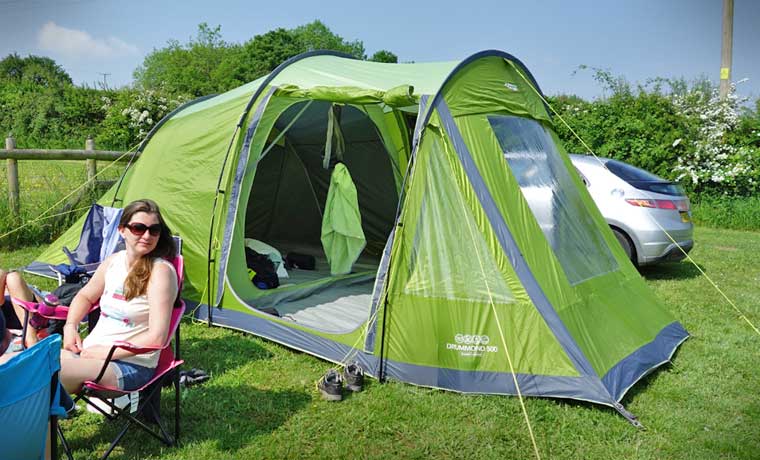
What I love the most about the Vango Drummond 500
Everyone that has stayed with me in the tent so far has been super impressed with how spacious it is. And I couldn’t agree more. I’ve had 6 people sitting comfortably on the floor of the porch having a cream tea and playing games! 4 adults on camp chairs sat around a table in the porch, and still plenty of space to cook a meal and move around. And although it is a large tent, I think it’s the side entrance design coupled with loads of natural light coming in that makes it feels some homely, and never cramped.
What I don’t love so much about the Vango Drummond 500
There may be a reason for this, although I’ve yet to figure it out, but there is only a mesh panel on one of the side doors. We camped for a week in the middle of midge season. At sundown everything had to be done in the porch with the mesh door firmly zipped closed to avoid getting nibbled to death by the little beasties. But because the other side door doesn’t have a mesh panel, there was no through-breeze in the porch to keep things cool.
I also feel that the durability of some of the less important features may not be as good as they could be.
Verdict
The Vango Drummond 500 is a superbly well designed and spacious tent. With plenty of headroom, oodles of liveable space and a highly appealing ambiance, it’s the ideal tent for families, groups, or couples wanting a bit of luxury. It’s easy to put up, not massive once packed down, super stable for a tunnel tent, and has a very appealing price tag that offers unrivalled value.
We’re big fans and hope that it will serve us well for many, many years of camping ahead.
Find the latest price at:
Add Nature
Disclaimer: Cool of the Wild received this product free in return for an honest review. We only recommend gear that we love from companies we trust and we are under no obligation to give a positive review. All thoughts and opinions are that of the reviewer and we are in no way influenced by the brand or company.




